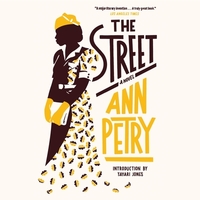Take a photo of a barcode or cover
dark
emotional
sad
tense
medium-paced
Plot or Character Driven:
Character
Strong character development:
Yes
Flaws of characters a main focus:
Yes
emotional
reflective
sad
tense
medium-paced
Plot or Character Driven:
Character
Strong character development:
Complicated
Loveable characters:
Yes
Diverse cast of characters:
Yes
Flaws of characters a main focus:
No
dark
reflective
sad
slow-paced
Plot or Character Driven:
Character
Loveable characters:
Complicated
Flaws of characters a main focus:
Yes
Seriously underrated American classic.
4.5 stars. Grim and depressing, Ann Petry’s fantastic book wonderfully described the ever-increasing stresses upon Lutie Johnson. A single mother trying to raise her son well and give them both better options than their current situation, I felt her exhaustion, fear, anger and frustration with all the ways a black woman and single mother with little money was constantly kept living on the edge. Lutie is well characterized, and I felt sadness but also anger at everyone trying to take advantage of her and her son. The story’s dark ending capped off all the other horrible things that happened in the book, but I am still so glad I read this book.
155th book of 2020.
The most scathing comment I ever received from a lecturer about my own writing was this: “Don’t confuse being literary with having no plot”—straight through the chainmail. The Street is a novel that is both brilliantly written and plotted; I don’t often mention a book being “well-plotted” because although many probably are, I don’t notice them as I did here. Petry has a true gift for moving between characters and their heads, never leaving the reader confused (that’s the first challenge) or unsatisfied (the ultimate challenge: to be stuck in a character’s head we don’t care for, or feeling like we are being drawn away from the action elsewhere are common feelings with perspective hopping); I felt neither of these feelings for the 400 pages Petry kept me.
“The Street was a literary event in 1946, the first novel by a black woman to sell more than a million copies…Her work endures not only because it illuminates reality, but because it harnesses the power of fiction to supplant it.”
—New York Times
The roster is small: Lutie Johnson, single mother in 1940s Harlem, trying to raise her 8-year-old son, Bub, amidst poverty, racism and “predators at every turn”. Bub, young and naïve, afraid of the dark, and caught between being a child and a man. Jones, the super of their building (116th street, Harlem), a rather mean, dog-kicking, neurotic, jealous man. His girlfriend, Min, who is caught with a man who is both obsessive and violent, looking for escape and freedom (something all the characters yearn in one way or another, making the novel suffocating). Mrs Hedges, a woman who lives upstairs, like the Big Brother of the street—watching. Junto and Boots, two men who are drawn into the story through Lutie’s desperation of earning money.
With a smattering of other characters, The Street is made up almost entirely from the names above, dipping into their heads, their lives and ultimately, a great number of flashbacks too (also, risky; it is a miracle this book doesn’t fail). Petry effortlessly and seamlessly glides through their heads and their pasts as they struggle, in their own ways, around 116th street and Harlem itself. Though the novel is “realist”, in the way Raymond Carver is described as realist, there is a shocking amount of tension in the novel. It is 400 pages long but felt like 200. I was uncomfortable, angry and in awe for the entire novel.
A literary, social commentary, page-turner attacking race, sexism and the American Dream in a single novel; it is a rare book: tense, sad, ambitious, and no doubt, seminal.
I was too angry to be sad while I was reading it, but that had worn off by the end; by then my anger and my sadness were level with one another.
The most scathing comment I ever received from a lecturer about my own writing was this: “Don’t confuse being literary with having no plot”—straight through the chainmail. The Street is a novel that is both brilliantly written and plotted; I don’t often mention a book being “well-plotted” because although many probably are, I don’t notice them as I did here. Petry has a true gift for moving between characters and their heads, never leaving the reader confused (that’s the first challenge) or unsatisfied (the ultimate challenge: to be stuck in a character’s head we don’t care for, or feeling like we are being drawn away from the action elsewhere are common feelings with perspective hopping); I felt neither of these feelings for the 400 pages Petry kept me.
“The Street was a literary event in 1946, the first novel by a black woman to sell more than a million copies…Her work endures not only because it illuminates reality, but because it harnesses the power of fiction to supplant it.”
—New York Times
The roster is small: Lutie Johnson, single mother in 1940s Harlem, trying to raise her 8-year-old son, Bub, amidst poverty, racism and “predators at every turn”. Bub, young and naïve, afraid of the dark, and caught between being a child and a man. Jones, the super of their building (116th street, Harlem), a rather mean, dog-kicking, neurotic, jealous man. His girlfriend, Min, who is caught with a man who is both obsessive and violent, looking for escape and freedom (something all the characters yearn in one way or another, making the novel suffocating). Mrs Hedges, a woman who lives upstairs, like the Big Brother of the street—watching. Junto and Boots, two men who are drawn into the story through Lutie’s desperation of earning money.
”You don’t want to fight?”
“Why should I?”
“I don’t know. I’m asking you.”
He had pulled a chair out and sat down across from Junto. “Listen, Junto,” he said. “They can wave flags. They can tell me the Germans cut off baby’s behinds and rape women and turn black men into slaves. They can tell me any damn thing. None of it means nothing.”
“Why?”
“Because, no matter how scared they are of Germans, they’re still more scared of me. I’m black, see? And they hate Germans, but they hate me worse. If that wasn’t so they wouldn’t have a separate army for black men. That’s one for the book. Sending a black army to Europe to fight Germans. Mostly with brooms and shovels.”
…
“Don’t talk to me about Germans. They’re only doing the same thing in Europe that’s been done in this country since the time it started.”
With a smattering of other characters, The Street is made up almost entirely from the names above, dipping into their heads, their lives and ultimately, a great number of flashbacks too (also, risky; it is a miracle this book doesn’t fail). Petry effortlessly and seamlessly glides through their heads and their pasts as they struggle, in their own ways, around 116th street and Harlem itself. Though the novel is “realist”, in the way Raymond Carver is described as realist, there is a shocking amount of tension in the novel. It is 400 pages long but felt like 200. I was uncomfortable, angry and in awe for the entire novel.
Yes, she [Lutie] thought, if you were born black and not too ugly, this is what you get, this is what you find. It was a pity he hadn’t lived back in the days of slavery, so he could have raided the slave quarters for a likely wench any hour of the day or night. This is the superior race, she said to herself, take a good long look at him: black, oily hair; slack, gross body; grease spots on his vest; wrinkled shirt collar; cigar ashes on his suit; small pig eyes engulfed in the fat of his face.
A literary, social commentary, page-turner attacking race, sexism and the American Dream in a single novel; it is a rare book: tense, sad, ambitious, and no doubt, seminal.
I was too angry to be sad while I was reading it, but that had worn off by the end; by then my anger and my sadness were level with one another.
I liked this novel. Although it was written in the 40s, The style of the writing didn't seem dated at all, it read like it could have been written today. I liked how the author gave different characters space to explain their point of view, although i would have liked more of it towards the end. It touches on issues that black people had (and have) in those days, the relationships, frustration and misunderstandings between men and women, mothers and kids, neighbors, employers and employees, in Harlem, but could have applied to any urban area. A lot still can apply today. I would recommend if you haven't read the author's work before, or any novel set in Harlem.
Quite good and for a book written in the 1940s, surprisingly fresh.
Rating 9.6/10: .4 off for slow start, much needed context but I feel like the flow of the book really hit after the first 100 pages. The changing perspectives of each character was masterful, I could imagine the characters physically in my head, and I could imagine the world they lived in and the actions they were taking as I was reading. There were just enough characters to provide interesting perspectives and not too many characters where I felt lost. The writing was immersive to say the least, and the fact that it was written in the 1940s and is still relatable, timely, and important says it all. It was a book I will buy for myself and reread every couple years - which is high high praise from me. I think this book will continue to teach me something new each time I read it.
emotional
sad
medium-paced
Plot or Character Driven:
Plot
Strong character development:
Yes
Loveable characters:
Yes
Diverse cast of characters:
Yes
Flaws of characters a main focus:
Yes
The writing is excellent but the book is super depressing. I just finished the book and am still processing.



